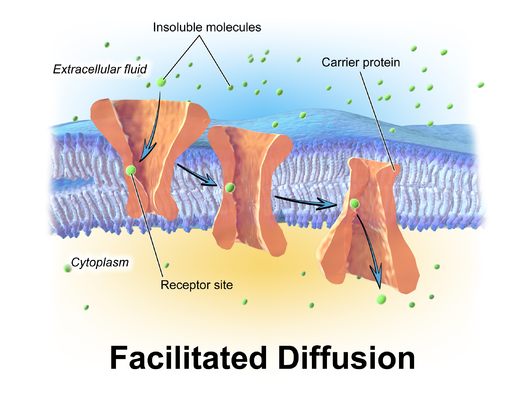Facilitated Diffusion Study Guide
Introduction:
Facilitated diffusion is a passive type of transport that does not need energy for the movement of molecules. So, let’s learn more about the process of facilitated diffusion along with the different types and examples.
What is facilitated diffusion?
The molecules move in the direction of the concentration gradient from a higher concentration region to a lower concentration region. This transport of molecules is guided with the help of proteins called transport proteins.
Is facilitated diffusion active or passive?
Facilitated diffusion does not need any energy for the movement of molecules as they move from higher concentration to lower concentration gradient. This means they obey Fick’s law.
Facilitated Diffusion vs Simple Diffusion:
Simple diffusion also follows the transport of molecules from higher concentration to lower concentration but in a free medium and does not have any barriers in its path. While in facilitated diffusion, the transport of substances occurs between the cells and their environment across a cell membrane. It is not a free flow of molecules across a cell membrane but is dependent on the presence of specific molecules that will aid in allowing their transport into and out of the cell. These molecules in the cell membrane are called transport proteins. This brings in other factors to play a role in the transport of molecules, such as the transport protein binding capacity with the molecule and the number of transport proteins, the saturation limit of the molecules, temperature, and other variables that will impact the transport protein function. So, the diffusion process need not reach the equilibrium state to stop the movement of molecules across the cell membrane.
Transport Proteins in. Facilitated Diffusion:
Transport proteins guide facilitated diffusion, and there are three types of facilitated proteins: channel protein, gated channel proteins, and carrier proteins.
Channel proteins are pores made through the membrane to transport water and small molecules like ions. Water channel proteins are called aquaporins, while ion channel proteins can be named based on the type of ions such as sodium transporter, potassium transporter, and so on.
A gated channel protein has a “gate” operated by a stimulus to allow or block the passage of molecules. The stimulus can be chemical, physical, electrical, temperature, or mechanical.
Carrier proteins transport molecules across the membrane by changing conformation. A change in conformation pushes the molecules across the cell membrane. These transport proteins regulating the facilitated transport are transmembrane proteins, and these proteins span across the entire cell membrane.
Facilitated diffusion is needed to transport molecules that do not comply with the cell membrane to communicate or pass through it. The cell membrane repels them, but the cell requires those resources. Similarly, such chemicals and molecules are formed within the cell solution that must be expelled, but the cell membrane does not allow them to pass through it. Thus, it comes in handy as these transport proteins span the cell membrane as transmembrane proteins.
Example of facilitated diffusion:
Glucose Transporter is present in the alimentary canal of small intestines, which helps transport the glucose in the intestine to other parts of the body with the help of the blood vessels that absorb these glucose molecules. This is why the blood glucose level is essential. The glucose transporter proteins are carrier proteins that undergo conformational changes as glucose binds to them on the one side to deliver them on the other side of the cell and are back to position to take up another glucose molecule when the carried glucose molecule is released.Ion channels can be gated or plain channel proteins. They span across the cell membrane, resulting in the formation of pores. According to the need, they open and close based on variables like electrical and chemical potential. When ligand binding is needed for the conformational change of these proteins, they are said to be gated channels.
Conclusion:
- Thus, facilitated diffusion is an advanced diffusion process guided mainly by the concentration gradient.
- It makes the need for energy unnecessary for the completion of the process.
FAQs:
1. What is facilitated diffusion vs. simple diffusion?
Facilitated diffusion is the transport of molecules from higher concentration to lower concentration without the need for any energy across a cell membrane. In contrast, simple diffusion is the transport process of molecules in the direction of concentration gradient without any barriers until the equilibrium is attained. In facilitated diffusion, which usually happens in a cell, the inner environment of the cell decides the volume of transfer of molecules, making use of the differences in the concentration gradient, thereby being regulated.
2. What travels in facilitated diffusion?
The solutes travel in facilitated diffusion. Water molecules also travel across the cell membrane, using a facilitated diffusion process with the help of channel proteins called aquaporins.
3. What is an example of facilitated diffusion?
Glucose transport is an excellent example of the transport of molecules using the facilitated diffusion process.
4. Is facilitated diffusion faster than active transport?
Facilitated diffusion should be faster than active transport because it follows the concentration gradient and does not need the energy to drive the process.
5. How Does facilitated diffusion differ from active transport?
Facilitated diffusion does not need the energy to drive the movement of molecules against the concentration gradient-like active transport.
We hope you enjoyed studying this lesson and learned something cool about Facilitated Diffusion! Join our Discord community to get any questions you may have answered and to engage with other students just like you! Don’t forget to download our App and check out our fun VR classrooms – we promise, it makes studying much more fun 😎
Sources:
- Facilitated Diffusion https://apcentral.collegeboard.org/pdf/ap-biology-course-and-exam-description-0.pdf?course=ap-biology Accessed 30 Dec, 2021.
- Facilitated Diffusion https://bio.libretexts.org/Bookshelves/Introductory_and_General_Biology/Book%3A_Introductory_Biology_(CK-12)/02%3A_Cell_Biology/2.14%3A_Facilitated_Diffusion Accessed 30 Dec, 2021.
- Facilitated Diffusion https://www.biologyonline.com/dictionary/facilitated-diffusion Accessed 30 Dec, 2021.
- Facilitated Diffusion https://byjus.com/biology/facilitated-diffusion/ Accessed 30 Dec, 2021.


